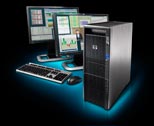The Z600 is the mid-range offering in HP’s new generation workstation family, the Z Series. It’s a dual socket machine, meaning it can have up to two physical CPUs (each with four cores), but is incredibly compact at the same time. In fact, despite being the only dual socket machine on test this month, it is the smallest out of all four. Our sensitive little ears also picked it out to be the quietest, and much of this is down to the impressive engineering that has gone into its design.
In addition to the carefully positioned fans and ductwork, one of the reasons for the excellent acoustics is the power supply, which has been completely redesigned from scratch. Unlike the standard box types, which have been around since desktops began, the Z600’s power supply runs the entire length of the chassis, taking in cool air at the front and expelling warm out of the back. This efficient process means it runs cooler so there’s less fan noise.

HP has also paid close attention to maintenance and in the unlikely event that the power supply should develop a fault it can be diagnosed and replaced without having to call an engineer out or return the whole machine to base. The user simply pulls the supply out by its handle, plugs it in to the mains and if there is no green light, the fault is confirmed and HP will ship out a replacement power supply which can be easily installed by the user.
The ease of maintenance is reflected throughout the chassis, which is almost toolless, bar one cable. The graphics card and hard drives clip in and out with ease, as do the cooling fans which don’t even need wires to draw power as funnel shaped blind mate connectors guide them into place. A lot of thought has also gone into the exterior design of the chassis and two handles make it incredibly easy to lift and move the machine about.
In terms of specifications, our review machine was kitted out with two Intel Quad-Core E5530 Xeon processors. Running at 2.4GHz these moderately specified CPUs are not going to set any performance records as far as CAD is concerned. However, when we got all eight cores working flat out in our 3ds Max Design rendering test, the advantage of a dual processor set up was clear.
Obviously higher GHz processors would be preferred, as you’d also get better performance in single threaded applications like SolidWorks and Inventor. However, this would bump up the price a fair bit and dual processor machines don’t come cheap.
6GB RAM is standard in modern dual processor workstations and plenty for average CAD users. However, those that work with particularly large models, or want to run multiple applications or CAE simulations concurrently would need to think carefully about an upgrade at time of purchase. With all six slots taken with 6 x 1GB DIMMs, a later upgrade to 12GB would require all the modules to be swapped out for 12GB DIMMs. Of course, anything over 3GB requires a 64-bit operating system and in this case it’s Windows Vista Business. For those that prefer Windows XP, and there are many, then this is also available as a free downgrade.
All in all the Z600 is a beautiful piece of engineering. It’s one of the most innovative designs to have graced this sector in years. However, choice of specification is crucial. While many other specifications are available, as it stands with two 2.4GHz Intel E5530 Xeon processors, the machine will probably only appeal to a niche group of 3D users. While it delivered good performance in our 3ds Max rendering test, dedicated design visualsation specialists are likely to find the mid-range AMD ATI FirePro graphics card, coupled with a 2.4GHz processor, a little uninspiring. As a result, it’s in the realms of Computer Aided Engineering (CAE) – with multithreaded CFD and FEA applications the likely beneficiaries of its eight processing cores – that it should find most interest.
How we benchmark workstations at Develop3D
» 2 x Intel Xeon E5530 processors (2.4GHz)
» 6GB (6 x 1GB) DDR3 memory
» HP motherboard (Intel 5520 chipset)
» 500GB Samsung hard drive (7,200RPM)
» AMD ATI FirePro V5700 (512MB) graphics card
» Windows Vista Business x64 (with free Windows XP x64 downgrade)
» 3 year worldwide parts, labour and next business day on-site warranty
» Benchmarks
Graphics (frames per second – bigger is better) SolidWorks 2009 – 18.3 3ds Max Design 2010 – 2.7 Inventor 2010 – 2.6
CPU (secs – smaller is better) 3ds Max Design 2010 – 218
To find out how DEVELOP3D benchmarks workstations click here
2 x Intel Xeon E5530 (2.4GHz)
6GB (6 x 1GB) DDR3
AMD ATI FirePro V5700 (512MB)
HP (Intel 5520 chipset)
500GB Samsung (7,200RPM)
3 year worldwide parts, labour and next business day on-site
http://welcome.hp.com/country/uk/en/welcome.html#Product






